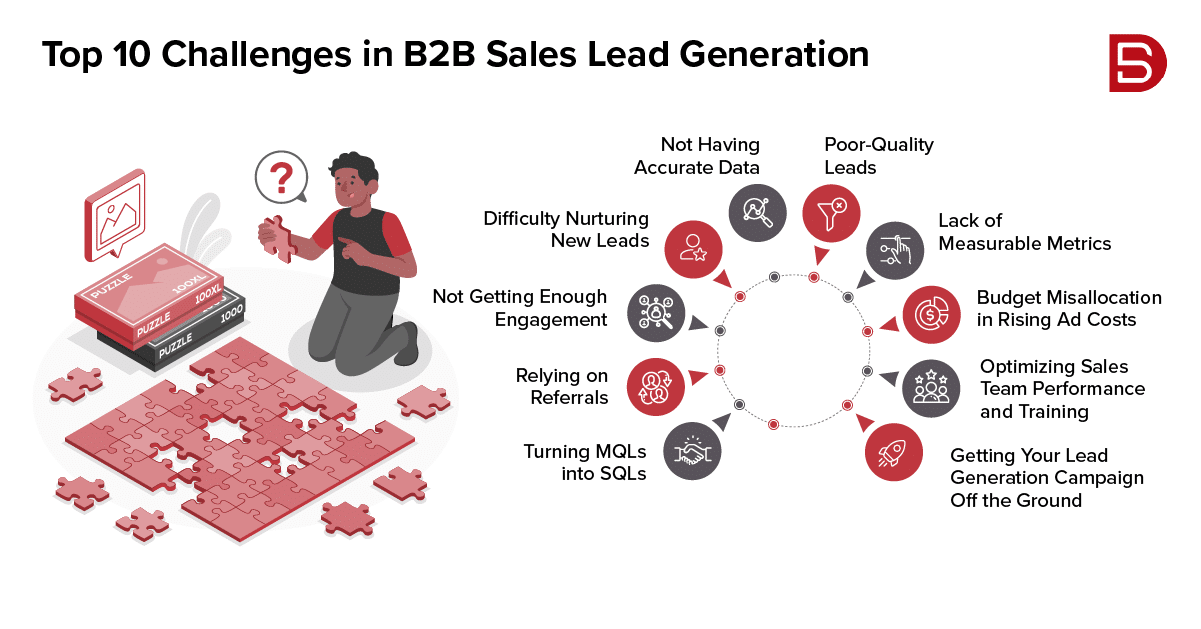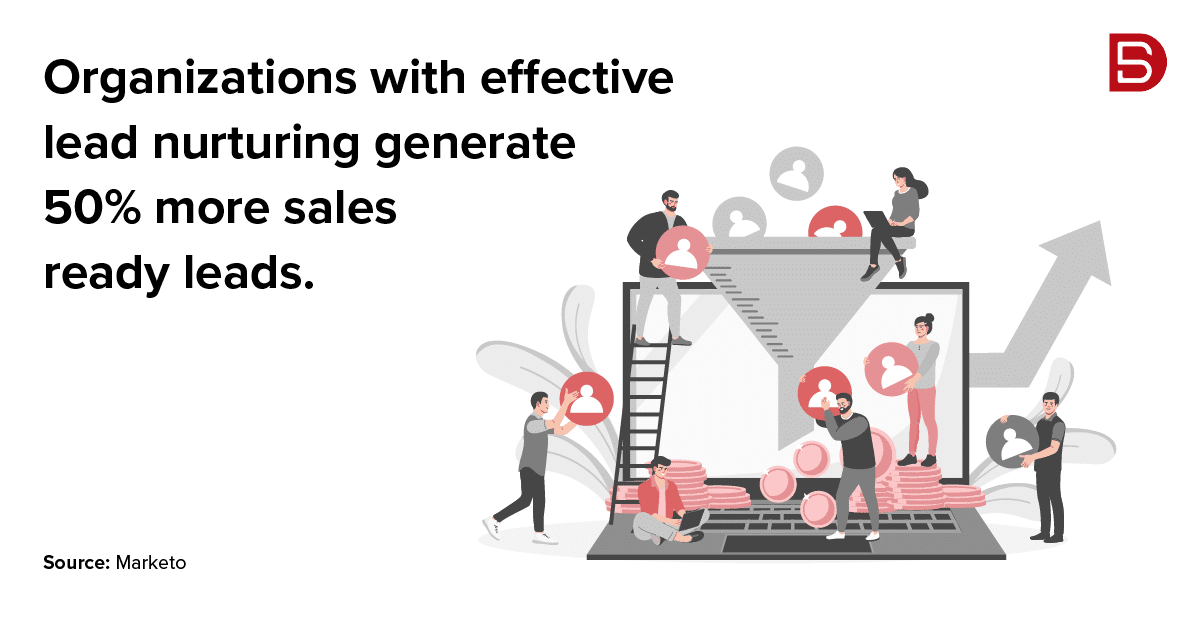Generate high quality leads! That is the primary objective for marketing team in all B2B companies out there. It is the key to expanding your business, growing your client base, boosting revenue, and fortifying your sales pipeline. In It is an absolute must for serious business growth. However, a considerable number of businesses face substantial hurdles in the sales lead generation process.
Let us understand this better. According to a report by Ruler Analytics, 37.1% of marketers say that inbound lead generation is difficult. Similarly, Pipedrive’s State of Sales survey reveals that 51% of sales professionals encounter difficulties in generating leads.
Low conversion rates or low quality leads are some of the most common challenges. But how do you deal with these? Neglecting such challenges can potentially lead to a dried up sales funnel. In this article, we’ll explore some of the most common B2B sales lead generation obstacles and provide effective solutions to ensure your business not only survives but thrives.
 Select an element to maximize. Press ESC to cancel.
Select an element to maximize. Press ESC to cancel.Top 10 Challenges in B2B Sales Lead Generation
Challenge 1: Turning Marketing Qualified Leads into Sales Qualified Leads
Turning Marketing Qualified Leads (MQL) into Sales Qualified Leads (SQLs) isn’t like taking a walk in the park. First, not all MQLs are looking to buy. And figuring out which ones are truly interested can be a real head-scratcher.
The industry standard of MQL to SQL conversion averages at 13%. This means that out of 100 marketing qualified leads, only 13 becomes an opportunity for sales. However, this number can vary significantly as well.
An MQL can show interest in your product or service by maybe downloading a whitepaper or attending a webinar. But interest doesn’t always mean buying intent. The challenge arises when marketing hands over these MQLs to sales, only for them to stall in the pipeline or be deemed unready for direct sales engagement.
This also highlights the fact that many a time, the marketing and sales teams are not aligned with the lead qualification system. The definitions might vary, and a prospect pushed too early can lead to them getting disqualified. Or worse, sit idle in the sales pipeline for months.
There also comes the issue with lead nurturing. If an MQL is not nurtured properly before handing them over to the sales, it might lower the quality.
The Solution:
First, it is essential to establish effective communication between your sales and marketing teams. Define explicitly the criteria for both MQLs and SQLs. This will ensure alignment between the teams. This clarity will also help in accurately identifying when a lead is ready to transition to sales.
You can also assign a lead scoring system to the leads. This can be based on multiple criteria including engagement, demographic, location, and more. With such a scoring system in place, you can prioritize only those MQLs that show a higher likelihood to purchase.
Also, nurture those MQLs. Develop targeted content and campaigns that addresses their specific needs or their pain points. Effective nurturing keeps potential customers engaged and moves them closer to a purchasing decision.
Challenge 2: Relying Too Much on Referrals
Referrals are a great source of B2B sales lead generation. In fact, it is deemed extremely effective as a sales lead generation technique. 71% of B2B sales personnel, 75% of sales leaders, and 70% of marketers report higher conversion rates from referrals compared to other non-referred leads according to a study. In fact, 69% of companies with referral programs note that referred leads close faster than non-referred ones.
But relying on them as your primary source of lead can be risky. They are unpredictable, slow to scale, and dependent on external goodwill. An existing client can only recommend you to so many people within the industry. Also, referrals might not align with your target market or audience. This may lead to mismatched opportunities.
The Solution:
It’s about finding the right balance. While use those referrals because let us be real, we cannot deny the advantages. But mix it up with other B2B sales lead generation techniques. To broaden your horizons and reel in more quality leads, consider mixing in other lead generation tactics like email marketing, telemarketing, and content marketing.
In the B2B world, attending industry conferences and offering free product samples can help you gain warm leads. You’d be amazed at how many procurement bigwigs are on the hunt for such opportunities.
In a competitive arena, you’ve got to use every reasonable means to set yourself apart and gain an edge. Who knows, adding another quality lead source to your referrals might just be the boost your business needs.
Challenge 3: Not Engaging Your B2B Sales Lead
Okay, I am going to be honest with you. Lead engagement is a hurdle that many don’t want to talk about. Studies show only 29% of customers feel engaged, while 60% are indifferent and 11% actively disengage with you. Furthermore, 46% of B2B buyers feel like they are treated as mere numbers, and 85% believe companies should better utilize collected data to enhance experiences.
Lack of engagement leads to diminished brand loyalty. So even if a lead showed interest initially, lack of engagement can make them cold. A lead that landed on your landing page with no better interaction will never go down the sales pipeline.
The Solution:
Before you kick off any B2B sales lead generation campaign, do your homework. Tailor your content and communications to address individual customer needs and preferences. This demonstrates that you understand their pain points and might be able to offer exactly what they are looking for.
Also, utilize various channels such as social media, email, webinars, and in-person events. Consistent and valuable interactions can be the key to ensure that your leads never go cold. You can always consider partnering with a B2B sales lead generation companies to enhance your campaign’s reach and results.
Adopting these approaches can bridge the engagement gap. It can help develop to a more meaningful customer relationship and improved business outcomes.
Challenge 4: Difficulty Nurturing New B2B Sales Leads
A Marketing Sherpa study showed that 79% of MQLs do not convert into SQLs due to lack of nurturing. Moreover, a Forrester Research shows that companies that excel at lead nurturing generate 50% more sales-ready leads at a 33% lower cost.
Now, you might argue that you are engaging with your leads just fine. So, why is your B2B lead generation falling flat over its face? Well, it is crucial to understand that lead engagement and lead nurturing might be similar, but they are not the same.
While lead engagement refers to the real time interaction between a prospect and your brand, lead nurturing is a long-term process designed to educate, build trust, and guide potential customers toward a purchase decision.
Nurturing is the overall strategy of guiding a lead over time. Engagement is the measure of how active and responsive a lead is at any given moment. So even if you are engaging right, if a lead is not nurtured right, it will slip through the cracks.
Now, the question arises: How can you effectively nurture these leads and keep them from falling off the radar?
The Solution:
The answer is to implement a consistent engagement strategy with your new leads. To ensure they don’t get lost, it’s crucial to fine-tune your B2B sales lead nurturing strategies. Start by establishing regular interaction. Whether it’s through weekly updates, frequent blog posts, or daily accountability calls, tailor your approach to your audience’s preferences.
The goal is to keep them engaged without overwhelming them. Furthermore, consider offering highly personalized content that resonates with each lead individually. While this approach may require extra effort, it can significantly improve lead retention.
Challenge 5: Not Having Accurate Data
One of the critical challenges in B2B sales lead generation is the absence of a reliable and up-to-date marketing database. Without such a database, your lead generation efforts can be severely hampered. In fact, Gartner estimates that poor data quality costs organizations an average of $12.9 million annually.
Accurate data is crucial for the success of your sales lead generation and also for maximizing the value and profitability of your efforts. Another study found out that bad data wastes over 27% of a sales person’s time.
In a world where time is of the essence, wasting efforts on bad data is absolutely unacceptable.
The Solution:
To resolve the challenge of inaccurate data in lead generation, consider centralizing and maintaining an up-to-date marketing database. Employ lead generation tools that come with data enrichment and validation. With AI becoming a thing of today, use such automated tools that can validate data entries in real time to reduce errors.
By addressing data inaccuracy, you can ensure better B2B sales lead generation outcomes, drive profitability, and foster a more collaborative work environment. Furthermore, to enhance your data quality, consider leveraging data enrichment services that can keep your database up-to-date and comprehensive.
 Select an element to maximize. Press ESC to cancel.
Select an element to maximize. Press ESC to cancel.You can also read: 6 Highly Effective B2B Lead Generation Strategies & Techniques
 Select an element to maximize. Press ESC to cancel.
Select an element to maximize. Press ESC to cancel. Select an element to maximize. Press ESC to cancel.
Select an element to maximize. Press ESC to cancel. Select an element to maximize. Press ESC to cancel.
Select an element to maximize. Press ESC to cancel.Challenge 6: Attracting Poor-Quality Leads
Oh, the age old poor-quality leads debate! In fact, this takes us back to the first challenge. A study showed that 48% of marketers send MQLs to sales without qualifying them properly. And 42% of sales people complain that poor quality leads are a massive challenge.
The Solution:
The answer lies in prospect qualification and redefining your ideal customer persona (ICP). Similar to how companies implement quality control for their products, having standards for your future clients is essential for business success.
To ensure better quality of your B2B sales leads, begin by defining your ICP. Ensure that you actually have the buyer’s persona well laid out for both your marketing and sales team to understand. This adjustment will naturally qualify your prospects based on your content and strategies.
In B2B sales lead generation, prioritize lead quality, as it lays the foundation for increasing quantity in the long run.
Challenge 7: Lack of Measurable Metrics
As management guru Peter Drucker wisely said, “if you can’t measure it, you can’t manage it.” This principle applies to B2B sales lead generation too. Without the ability to measure the success and costs of your lead generation campaigns, managing them effectively becomes a daunting task.
So, how do you know if the campaign is working? If it is, how can you be certain there’s no room for improvement? And, most importantly, how do you ensure you’re getting the best possible returns on your campaign resources? Not having answers to these questions is not a good place to be in.
The Solution:
To guarantee the success of your campaign and the ability to react promptly if things go off track, it’s imperative to prioritize accurate data collection. But what should you measure? Everything that’s measurable, such as website visitors, email sign-ups, or the number of leads generated per advertising dollar spent. The more data, the better.
However, it’s crucial not to collect data for data’s sake. You must also analyze it and take action when necessary. If your data indicates that email marketing isn’t generating leads, it’s time to examine your email copy and identify what’s amiss.
In essence, collecting data is vital, but it’s the analysis and informed action that truly drive campaign success
Challenge 8: Budget Misallocation in Rising Ad Costs
With the increasing use of the internet, businesses are spending heavily on ads. This increased demand is driving up ad costs. Small businesses with limited advertising budgets may face a significant challenge, especially if pay-per-click (PPC) ads don’t deliver substantial visitor traffic. However, there are lead generation strategies to make the most of this situation.
 Select an element to maximize. Press ESC to cancel.
Select an element to maximize. Press ESC to cancel.The Solution:
To combat the surge in ad prices, it’s vital to concentrate on highly specific keywords with low to medium competition. Understanding how ad pricing works is essential, particularly as Google’s ad space is limited. When competing for broad and generic keywords, you might end up having to bid higher due to fierce competition.
However, you can circumvent this by focusing on specific keywords. You can also opt for long-tail keywords that align with your business. Keywords with decent volume, high intent, and low competition can help you pave the way. This strategy also reduces ad costs significantly.
By creating specific, high-quality ads, you can both reduce the price of your service or product ads and attract high-quality prospects. Prioritizing specific keywords and leveraging user persona and ICP allows for effective management of ad pricing.
Challenge 9: Optimizing Team Performance and Training
To achieve your business goals, you need to know if your team is performing well. You need to ensure that they have the right tools with them. Often times, teams fall short of their goals because of the assumption that prior experience automatically fills knowledge gaps about a specific product. However, experience in one area may not seamlessly transfer to another.
 Select an element to maximize. Press ESC to cancel.
Select an element to maximize. Press ESC to cancel.The Solution:
To enhance performance, it’s essential to establish a regular review system in place. A successful sales lead generation campaign should provide scripts. It should include marketing automation tools to reduce redundancy. It should provide training on how to handle client concerns, and effective questioning techniques.
Monitor their calls and campaigns. Identify the errors. This will help you take corrective measures before it is too late. Consistent benchmarking can create clear expectations and maintain everyone’s alignment. The integration of AI-powered sales Quality Assurance (QA) solutions can automate and streamline the feedback and improvement process.
Challenge 10: Getting Your Lead Generation Campaign Off the Ground
So, you have everything in place. Your campaign looks perfect on paper. The plans are laid out. The world is yours to conquer. And then the worst thing that could happen, happens. Planning a B2B sales lead generation campaign is monumental but easy when you know what you are planning to achieve. It is the launching part that many flounder in.
See a B2B sales lead generation campaign can be overwhelming. Why you ask? Well, these campaigns are dynamic. They change midway. Your plans can fall apart in the blink of an eye. But that is it. Pushing through is your only option, there’s a more manageable way to approach it.
The Solution:
Take it one step at a time. Don’t throw in the towel. Focus on the task at hand, and don’t let the big picture overwhelm you. So, what’s the first step in this journey? It’s all about getting to know your prospects inside out. Create an Ideal Customer Profile (ICP) and a detailed client persona. Dive deep into understanding every little detail about your potential customers.
Once you’ve got a crystal-clear picture of your prospects, the rest will start to fall into place. You’ll know where to find them, what they’re looking for, and the challenges they’re facing. This will guide you to a successful lead generation campaign.
Conclusion
Navigating the complexities of B2B sales lead generation can feel like an uphill battle. However, with the right strategies in place, success is within reach. Now that you are aware of the most common challenges and how to address them with a systematic approach, you can transform obstacles into opportunities.
Whether it’s converting MQLs to SQLs, attracting high-quality leads, or aligning sales and marketing, the key lies in understanding your audience, refining your processes, and staying adaptable in an ever-changing landscape. With a clear strategy and the right tools, you can turn these challenges into catalysts for growth.
Are you ready to take on the next step? Datamatics can guide you on your journey to lead generation success. With 40+ years of experience in the bag, Datamatics can help you with your entire lead generation process and more. Want to learn more about our services? Write to us at marketing@datamaticsbpm.com and our experts with reach out to at the earliest.
Subscribe to our newsletters and stay on top of the latest B2B sales lead generation trends.

Paul van de Kamp





